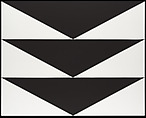Equilibrio
Carmen Herrera Cuban
Not on view
Herrera was a groundbreaking figure in geometric abstract painting starting in the 1940s, making her arguably the artist with the longest sustained exploration of the genre. As its title suggests, this symmetrical composition contains formal oppositions that the artist brought into balance. A stack of three flat isosceles triangles stands against a simplified background. The black and white areas of Herrera’s painting oscillate visually between positive and negative shapes. The painting’s stark, reductive palette manifests the artist’s study of seventeenth-century Spanish Baroque painting, which often features pronounced highlights and shadows—particularly the work of Francisco de Zurbarán (1598–1664), whom Herrera had described as a "minimalist."
Due to rights restrictions, this image cannot be enlarged, viewed at full screen, or downloaded.


